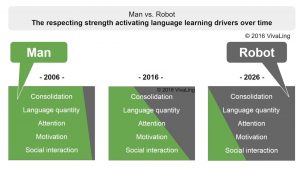At the recent EdTechXAsia 2016 event, an eminent speaker confirmed what all have been witnessing: contrary to initial fears, technology has not replaced teachers. But, he warned, “teachers proficient with technology will very soon replace those who are not.” The speaker knew what he was talking about : he was none other than Dr. Janil Puthucheary, Minister of State at the Ministry of Education of Singapore, the country that topped all global PISA rankings in 2016.
The digital leap and the rise of the (good) teacher are two of three current mega trends that we previously explored while reflecting on the future of language learning. These two phenomena are intertwined. With the coexistence of Man and Robot, there will be dramatic adjustments and power shifts. There will be winners and losers. At this stage you may be wondering what to do to remain off the endangered species list.
We very much agree with Dr Puthucheary’’s view that teachers’ inherent value is increased by their ability to leverage technology. As a facilitator in an enhanced learning environment, the tech-enabled teacher offers more and better learning choices to her students. But this is only the beginning of the story. The rest of the story is that many teaching tasks are now performed better by machines than they are by humans. “Better” can be understood as more consistently, more accurately, more effortlessly, more teaching-effectively or more cost-effectively. Is there any need left for humans when it comes to enunciating a grammar rule, teaching vocabulary, drilling, correcting pronunciation, consolidating knowledge? There isn’t. As a matter of fact, when a teaching task can be fully and unambiguously described as “specialized, routine, predictable” (as Martin Ford, the author of The Rise of the Robots, put it in 2015), chances are machines have already taken over.
The saving grace for teachers is that several of the language learning drivers (as introduced in VivaLing’s ViLLA © ) remain much better activated nowadays by Man than they are by Robot. Let us go over these language learning drivers, from the least to the most favourable of Man over Robot.

- Consolidation. In addition to the natural occurrence during sleeping phases, knowledge consolidation happens when memory is retrieved at the right time and in the right manner. Robots are already more effective at implementing well-known spaced repetition algorithms. They are also improving at memory retrieval techniques which diversify the ways a given piece of knowledge is tested, activated or reinforced.
- Language quantity. Computers are already tireless when it comes to offering unlimited language input to learners. Their ability to bring about learner output i.e. language production, however, is more difficult to control. As to providing feedback, today it can only happen in very structured environments such as Multiple Choice Questions or True / False questions, but not in natural language.
- Attention. Is the learner’s attention wandering randomly? A teacher can help them focus on the right elements. Machines can too, when highlighting specific elements to focus on. But the risk remains that the learner’s attention will just drift away, in the absence of a “big brother” watching and with the computer environment sometimes even adding to the distraction.
- Motivation. Machines have already made significant progress to satisfy extrinsic motivation by providing badges and rewards. But humans still have a significant edge by the timely and adapted encouragement they can provide with the right choice of words and body language. They can also outperform machines in personalization (content and pace), which greatly enhances learner motivation. However truly adaptive learning is high on robot makers’ roadmap and catching up fast.
- Social interaction. This is where the ultimate human advantage lies. Social interaction is an absolute requirement for younger children, and strongly recommended for true communicative language learning at all ages. As long as robots cannot fool children, human teachers will remain more effective at teaching. A few weeks ago, a famous US language app at the leading edge of technological disruption launched its chat bots. But after trying them out, we were surprised to note that these bots chat only in writing and in a rigidly structured context, make unexpected grammar mistakes and even used … suspiciously flirtatious vocabulary. They are still very far from matching authentic human interaction.
When adding a historical perspective to all the language-learning drivers, it becomes apparent that Robots are increasingly encroaching on what used to be Man’s exclusive teaching territory. For some drivers, such as consolidation or language quantity, the Robot has already made huge inroads and will soon undeniably and irreversibly overtake Man. Regarding other drivers, such as social interaction, Robots are further or even much further off. But let us keep in mind that Google’s AlphaGo beat the world’s best Go player in the world decades before it was anticipated. Artificial intelligence is making steady progress and it will most likely take no more than a generation or two for a bot to fool a child language learner.

It is even more important today for teachers to master the technology that is available, and to elevate their teaching skills to specific domains and levels still protected from the rise of the Robot. If a teacher is simply requested to deliver a pre-scripted lesson without being able to deviate from it, let there be no mistake: the teacher will be replaced by a Robot before they know it. But if they nurture the pedagogical expertise and social skills to truly offer a superior language learning experience to the learner, they will thrive.
Teachers are not naturally equipped with these skills, and are not sufficiently prepared to embrace their human advantages in traditional teacher training programs. This is why programs such as VivaLing’s VOLT-YL for teaching languages to children online are progressively preparing them adjust to the fast-changing teaching paradigms.





